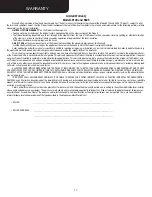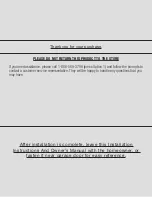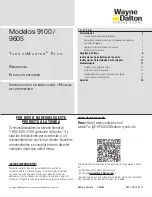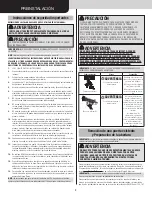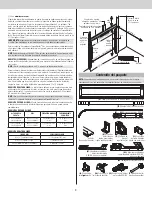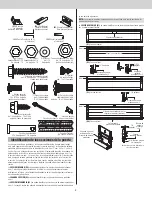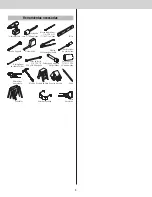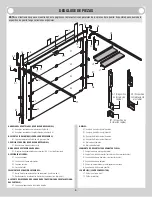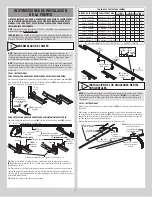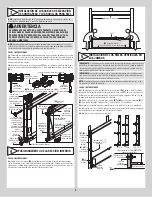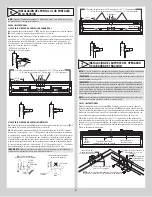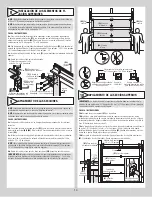
ADJUSTING COUNTERBALANCE LIFT CABLE
18
STEP 18 INSTRUCTIONS
18a.
Starting on the right side, adjust the cable drum assembly
(I5.)
by rotating the drum
until the set screw faces directly away from the header. The position of the cam peak on the
spring tube
(I2.)
should be pointing straight up.
18b.
Loosen the set screw no more than 1/2 turn. Ensure counterbalance lift cable is aligned
and seated in the first and second grooves of the cable drum. Pull on the end of the cable to
remove all cable slack.
18c.
Snug the set screw and then tighten an additional 1-1/2 turns. Measure approximately
6” of cable and cut off excess cable. Insert end of the cable into the hole of cable drum.
Repeat for left hand cable drum assembly.
IMPORTANT:
Ensure the counterbalance lift cable is seated in the first groove of the cable
drum prior to winding the springs.
NOTE:
Illustration shows the right hand cable drum assembly. Repeat the same process for
the left hand side.
Cam peak
pointing straight up
Insert
cable here
6”
Cut cable here
Tighten
set screw
(I2.)
Spring
tube
Counterbalance
lift cable
Insert
cable here
First groove
(I5.)
Cable drum assembly
WINDING THE SPRING(S)
19
IMPORTANT:
Verify that there are no obstructions in the travel path of the door sections or
counterbalance lift cables.
IMPORTANT:
Inspect each counterbalance lift cable making sure it is seated properly onto
the cable drum and that both counterbalance lift cables have equal tension.
STEP 19 INSTRUCTIONS
PRIOR TO WINDING SPRING(S), CHECK COUNTERBALANCE LIFT CABLES FOR EQUAL
TENSION:
19a.
Attach locking pliers to track above top roller.
19b.
Grasp cable at approximate mid-door height location.
19c.
Draw cable toward you about 1/2” to 1” and release, noting the response of the cable.
19d.
Repeat above steps for other cable.
19e.
Adjust cable tension as needed until right and left cables both respond the same.
WARNING
EXTREME CAUTION SHOULD BE USED WHEN WINDING SPRINGS AS
FAILURE TO FOLLOW THE INSTRUCTIONS OR USE THE PROPER TOOLS
CAN LEAD TO SERIOUS INJURY TO PERSONS AND PROPERTY. BEFORE
ATTEMPTING TO WIND THE SPRING, MAKE SURE YOU HAVE READ
AND UNDERSTAND THE INSTRUCTIONS. IF YOU ARE UNCLEAR ON ANY
ASPECT OF THE INSTALLATION PROCEDURES, YOU SHOULD CONSULT A
TRAINED DOOR SYSTEMS TECHNICIAN.
WARNING
IT IS RECOMMENDED THAT LEATHER GLOVES BE WORN WHILE WINDING
SPRINGS. FAILURE TO WEAR GLOVES MAY CAUSE INJURY TO HANDS.
NOTE:
A 3” ratchet extension is recommended for added clearance from the horizontal
track angle.
IMPORTANT:
Pawl knob must be in upper position to add / remove required number of
spring turns.
19f.
There are two methods for counting the spring turns as you wind. One method is to
identify the black tooth on the ratchet wheel inside of the end bracket. When the wheel
makes one revolution and the tooth returns to its starting point, one turn has been made. The
other method is to make a mark on the winding shaft (or socket) and end bracket, and count
your turns in this manner.
19g.
Check the Winding The Spring Turn Chart (below) for the required number of complete
turns to balance your door.
19h.
Starting on the right hand side, turn the pawl knob on the end bracket
(I4.)
to the upper
position. Using a ratchet wrench with a 5/8” socket and a 3” ratchet extension, wind the
spring by rotating the winding shaft counter clockwise, while watching either the black tooth
on the ratchet wheel or the mark on the winding shaft. After 2 to 3 turns, remove the ratchet
wrench and adjust the counterbalance lift cable on the left side. Ensure counterbalance lift
cables are in the first groove of the cable drums, as shown in Step 18 Adjusting Counterbal-
ance Lift Cable.
NOTE:
Single spring applications require no spring winding on the left hand side, but lift
cable tension needs to be adjusted.
FOR SINGLE SPRING APPLICATIONS:
Return to the right hand end bracket and continue
winding the spring to the required number of turns for your door following the double spring
instructions below. Place pawl knob in lower position.
FOR DOUBLE SPRING APPLICATIONS:
Either use the black tooth on the ratchet wheel
for winding reference or place a mark on the winding shaft and end bracket
(I3.)
. Place the
ratchet wrench with 5/8” socket and a 3” ratchet extension onto the left hand winding shaft
end. To wind the spring, rotate the winding shaft clockwise, while watching the black tooth on
the ratchet wheel or the mark on the winding shaft. Rotate the winding shaft to the required
number of winding turns for your door. Then return to the right hand side and wind the right
hand spring to the required number of turns. Place pawl knob in lower position on both sides.
Counterbalance
lift cable
(I4.)
Right hand
end bracket
Pawl knob
in upper
position
5/8”
Socket
Ratchet
wrench
Winding
shaft
3” Ratchet
extension
Marks
Counterbalance
lift cable
(I3.)
Left hand
end bracket
Pawl knob
in upper
position
5/8”
Socket
Ratchet
wrench
3”
Extension
Marks
Winding
shaft
IMPORTANT:
Mark the number of spring turns onto the end bracket warning tag.
WINDING SPRING TURN CHART
DOOR HEIGHT
SPRING TURNS
6’-0”
14
6’-3”
14-1/2
6’-5” - 6’-6”
15
6’-8” - 6’-9”
15-1/2
7’-0”
16
7’-3”
16-1/2
7’-6”
17
7’-9”
17-1/2
8’-0”
18
NOTE:
Since total turns to balance door can deviate from winding spring turn chart values
by ± 1 turn, adjustments to the recommended number of turns may be required after rear
back hangs are installed.
13

















